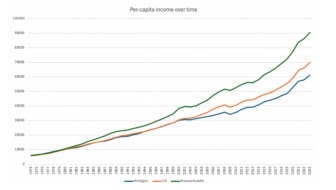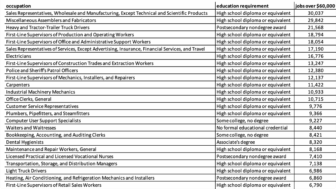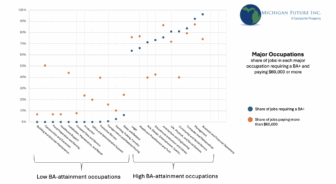In the report we released last week ![]() detailing our recommendations for redesigning Michigan’s education system, we target a range of areas for reform. From curriculum and pedagogy to funding and accountability, just about every facet of our education system calls for change.
detailing our recommendations for redesigning Michigan’s education system, we target a range of areas for reform. From curriculum and pedagogy to funding and accountability, just about every facet of our education system calls for change.
But if we had to pull one lever that would most dramatically change life outcomes for non-affluent Michigan kids, it would be to socioeconomically integrate our neighborhoods and schools.
Education research since the 1960s has found the composition of a school’s student body to be more strongly related to achievement than any other school factor. And in addition to the benefits of attending an integrated school, living in a low-poverty neighborhood impacts virtually every aspect of a child’s life, from exposure to crime to health outcomes to the perception of order – all of which have a dramatic impact on a child’s chance of success in life.
Unfortunately, however, more and more children are now living in high-poverty neighborhoods, and attending high-poverty schools. In 1970, 65 percent of families lived in mixed income areas; today, it’s just 40 percent, with more and more people segregated into either affluent or non-affluent areas. In metro-Detroit we have the distinction of being home to the most segregating border in the country, between Detroit and Grosse Pointe: a poverty rate of nearly 40% against a poverty rate of just 3%. And these residential class-based segregation patterns are of course mirrored in our schools.
In our report we offer two sets of recommendations to achieve greater socioeconomic integration. The first set deal with residential integration, which would accomplish the dual goal of integrating both our neighborhoods and schools. The second set of recommendations offers ideas for how we might integrate our schools, even if our neighborhoods remain segregated.
Residential integration
There are two major federal housing programs that funnel millions of dollars to Michigan every year: the Low Income Housing Tax Credit program and the Housing Choice Vouchers. Low Income Housing Tax Credits are offered to developers building affordable housing, and Housing Choice Vouchers are subsidies to low-income families to help defray the cost of housing. Both programs could be used to achieve greater socioeconomic integration. Currently, neither are.
Our state’s Low Income Housing Tax Credit program fails to incentivize developers to build in low-poverty neighborhoods. Other states do this explicitly through their qualified allocation plans, prioritizing projects that encourage integration.
Likewise, the Housing Choice Voucher program may help some families afford housing, but rarely does it help them move to better neighborhoods. Again, other regions – notably Baltimore and Dallas – have explicitly made integration a goal of their voucher program, and provide counseling services and variable vouchers to encourage moves to low-poverty neighborhoods.
Aside from making better use of federal money, our zoning laws are in need of an overhaul. Several states have laws requiring every municipality in the state to allow for 10% of their housing stock to remain affordable. Michigan, on the other hand, has a law explicitly barring a municipality from mandating affordable set-asides in new developments. We need to join the states that are demanding every community to do its part in affordable housing. This includes maintaining affordability in high-opportunity neighborhoods in central cities, where there may be ample affordable housing in the city as a whole, but limited affordability in low-poverty neighborhoods.
School integration
But even if we fail to achieve greater socioeconomic integration in housing, we can still do a better job of integrating our schools. To do so amidst residential segregation, however, would require inter-district cooperation, as much of the segregation we see in our schools occurs across, rather than within, districts. For example, 80% of students in Detroit attend a high-poverty school. Achieving intra-district integration in this setting would be impossible – there simply aren’t enough middle-class students. A regional approach is needed to achieve school integration, and there are a few different levers we can pull to make that happen.
The first is investing in high-quality magnet schools in central cities, an approach used most famously as part of a racial integration plan in Hartford, CT. In response to a 1996 civil-rights suit, the state provided funds for high-quality, theme-based magnet schools in Hartford to attract students from the suburbs, and provided suburban districts with “diversity incentives” to take students from city, transport them to school, and offer support services. It was remarkably successful, with 50% of Hartford students now attend an integrated school, up from 11% in 1996. This same strategy was used in New York State when John King, former Secretary of Education, was the education commissioner for New York State.
Other regional coordination efforts include a program in Minnesota under which the state offers districts “integration revenue,” to be used for inter-district integration efforts; strategically located charter schools, like the Mayoral Academies near Providence, RI, located on suburban/city borders, to draw students from both populations; strategic weighting in charter school enrollment and lottery policies, to intentionally draw a socioeconomically diverse class; and the full consolidation of urban and suburban districts, as seen in Wake County, NC and Jefferson County, KY.
Socioeconomic segregation often seems like a fact of life – regrettable, but just the way things are. But this isn’t the case at all. There’s a lot that we can do to encourage integration. But all of the actions above would require acknowledging socioeconomic segregation for the problem it is, and intentionally designing policies to address it.







